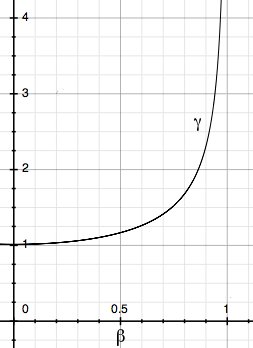Time stretch factor
From true
The time stretch factor is also the length contraction factor. Mathematically, it is usually abbreviated by the Greek letter gamma and calculated as

where β is the relative speed of the two frames expressed as a fraction of the speed of light.
So, for example, if two frames are moving relative to each other with a speed of 150,000 km/s, the time stretch factor would be

because the relative speed is 0.5c.
Since gamma is just a function of beta, it can be graphed easily. The graph shows that the time stretch factor is essentially 1 for slow speeds but that it increases to infinity as speed approaches the speed of light.
[edit] Use
This factor is very useful in a more mathematically advanced approach to spacetime which uses linear algebra. However, for this class it is less useful and must be used with care. It is only applicable in two situations:
- If one of the frames of reference has an object at rest with a known length, gamma can be used as a factor to compare the length of the object in other frames.
- If two events occur at the same place in one frame, gamma can be used as a factor to compare the time lapse between the events in other frames.
So be careful! Only use the time stretch factor or length contraction factor in these cases. Otherwise, you should use the spacetime interval.

